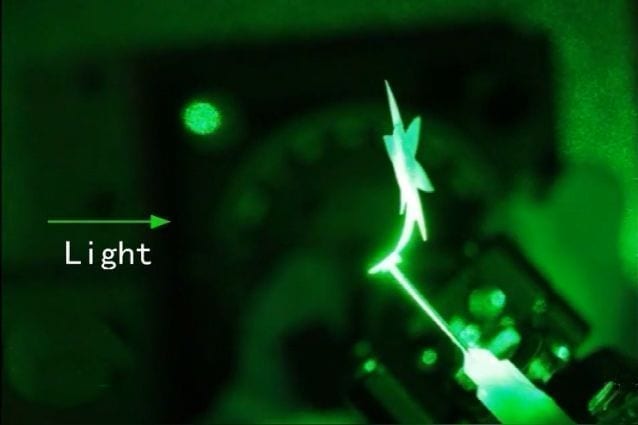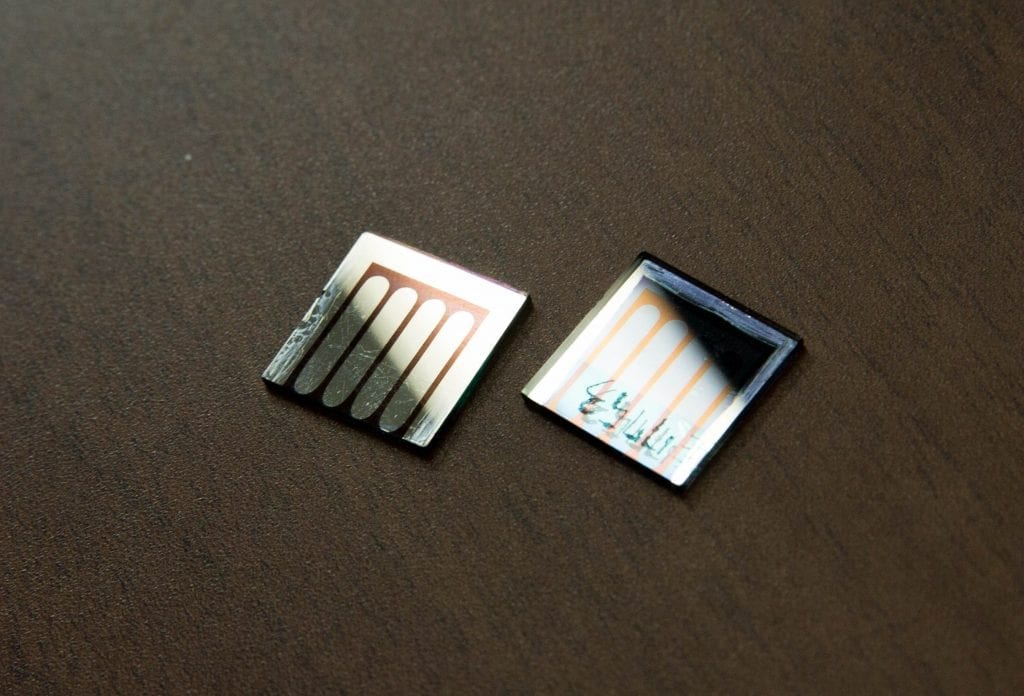
A photonic sunflower moves and tracks a source of light, maximizing exposure
Technology paves way for and other devices designed to move in response to light
Researchers at Tufts University School of Engineering have created light-activated composite devices able to execute precise, visible movements and form complex three-dimensional shapes without the need for wires or other actuating materials or energy sources. The design combines programmable photonic crystals with an elastomeric composite that can be engineered at the macro and nano scale to respond to illumination.
The research provides new avenues for the development of smart light-driven systems such as high-efficiency, self-aligning solar cells that automatically follow the sun’s direction and angle of light, light-actuated microfluidic valves or soft robots that move with light on demand. A “photonic sunflower,” whose petals curl towards and away from illumination and which tracks the path and angle of the light, demonstrates the technology in a paper that appears March 12th, 2021 in Nature Communications.
Color results from the absorption and reflection of light. Behind every flash of an iridescent butterfly wing or opal gemstone lie complex interactions in which natural photonic crystals embedded in the wing or stone absorb light of specific frequencies and reflect others. The angle at which the light meets the crystalline surface can affect which wavelengths are absorbed and the heat that is generated from that absorbed energy.
The photonic material designed by the Tufts team joins two layers: an opal-like film made of silk fibroin doped with gold nanoparticles (AuNPs), forming photonic crystals, and an underlying substrate of polydimethylsiloxane (PDMS), a silicon-based polymer. In addition to remarkable flexibility, durability, and optical properties, silk fibroin is unusual in having a negative coefficient of thermal expansion (CTE), meaning that it contracts when heated and expands when cooled. PDMS, in contrast, has a high CTE and expands rapidly when heated. As a result, when the novel material is exposed to light, one layer heats up much more rapidly than the other, so the material bends as one side expands and the other contracts or expands more slowly.
“With our approach, we can pattern these opal-like films at multiple scales to design the way they absorb and reflect light. When the light moves and the quantity of energy that’s absorbed changes, the material folds and moves differently as a function of its relative position to that light,” said Fiorenzo Omenetto, corresponding author of the study and the Frank C. Doble Professor of Engineering at Tufts.
Whereas most optomechanical devices that convert light to movement involve complex and energy-intensive fabrication or setups, “We are able to achieve exquisite control of light-energy conversion and generate ‘macro motion’ of these materials without the need for any electricity or wires,” Omenetto said.
The researchers programmed the photonic crystal films by applying stencils and then exposing them to water vapor to generate specific patterns. The pattern of surface water altered the wavelength of absorbed and reflected light from the film, thus causing the material to bend, fold and twist in different ways, depending on the geometry of the pattern, when exposed to laser light.
The authors demonstrated in their study a “photonic sunflower,” with integrated solar cells in the bilayer film so that the cells tracked the light source. The photonic sunflower kept the angle between the solar cells and the laser beam nearly constant, maximizing the cells’ efficiency as the light moved. The system would work as well with white light as it does with laser light. Such wireless, light-responsive, heliotropic (sun-following) systems could potentially enhance light-to-energy conversion efficiency for the solar power industry. The team’s demonstrations of the material also included a butterfly whose wings opened and closed in response to light and a self-folding box.
The research extends ongoing studies by Omenetto and colleagues at Tufts School of Engineering on the use of silk as an advanced material platform in photonics, electronics, and nanotechnology.
Original Article: Controlled by Light Alone, New Smart Materials Twist, Bend and Move
More from: Tufts University School of Engineering
The Latest Updates from Bing News & Google News
Go deeper with Bing News on:
Intelligent solar cells
- 3 Solar Stocks to Watch Amid Bleak Residential Installation View
The Inflation Reduction Act (IRA) benefits have been proven to be a solid growth catalyst for U.S. solar stocks, with the policy expected to drive an additional 160 gigawatts (GW) of solar over the ...
- Safety specialist embraces sustainability with major solar panel installation
Arco, a safety equipment supplier, has installed more than 2,300 solar panels on the rooftop of its National Distribution Centre in Hull. The National Distribution Centre (NDC) is the first of several ...
- Nextracker and JENNMAR Subsidiary JM Steel Bolster U.S. Supply Chain with New Facility Expansion to Triple Capacity for Solar Energy Projects
Nextracker (Nasdaq: NXT), a global provider of intelligent solar tracker and software solutions, and JENNMAR Holdings ("JENNMAR”) subsidiary JM Steel, a premier steel processing provider, jointly ...
- Launch of Tongwei Solar’s first G12N module ushers in 700W+ era
Tongwei Solar’s first G12N large-sized, high-efficiency module has rolled off the production line at the company’s Hefei base, marking its entry into the era of 700W+ modules.
- Why Teradyne Shares Are Trading Higher By Over 8%; Here Are 20 Stocks Moving Premarket
Teradyne posted adjusted earnings of 51 cents per share, beating market estimates of 33 cents per share. The company's quarterly sales came in at $599.819 million versus expectations of $566.310 ...
Go deeper with Google Headlines on:
Intelligent solar cells
[google_news title=”” keyword=”intelligent solar cells” num_posts=”5″ blurb_length=”0″ show_thumb=”left”]
Go deeper with Bing News on:
Light-activated composite devices
- Light-activated propulsion spins bacteria-shredding micromotors
The four spikes on a new nanocrystal developed in Spain spin up under light and move through liquid, blasting any bacteria unfortunate to be in their path. The development could spell trouble for ...
- The best smart home devices in 2024
the best smart home devices streamline your routine for complete convenience.
- Nanotechnology News
According to researchers, this has given the gold new ... Apr. 11, 2024 — New research is shedding light on one barrier to a clean energy future: corrosion. Using nanoscale imaging techniques ...
- Best Outdoor Security Lights With Cameras Of 2024
However, should they persist, or if you’d simply like to employ more robust security measures, adding a motion-activated security ... warranty, light brightness, video resolution and color ...
- How To Choose The Right Red Light Therapy Device
However easy they are to find, other tools, like red light therapy devices, often add a more wallet-gripping and confusing nuance to your “at-home spa” search. “You can easily incorporate ...
Go deeper with Google Headlines on:
Light-activated composite devices
[google_news title=”” keyword=”light-activated composite devices” num_posts=”5″ blurb_length=”0″ show_thumb=”left”]
[embedyt] https://www.youtube.com/embed?listType=playlist&list=PL0UjJ07OSXC83oV409r1yRju8-ihA1InJ&layout=gallery[/embedyt]










